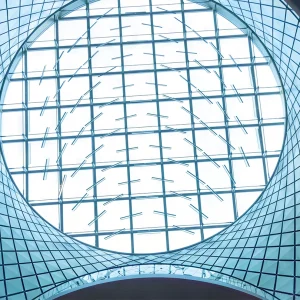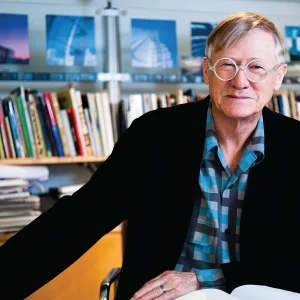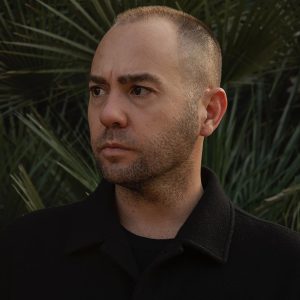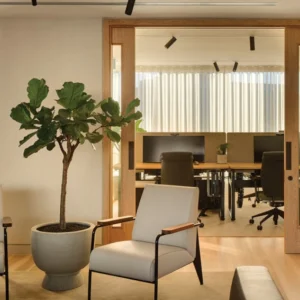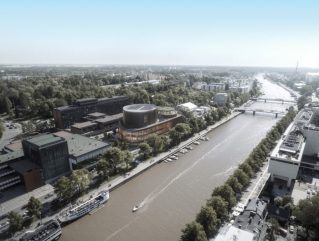
YOU KNOW YOU’RE in for an unusual kind of urban design research trip when your first night’s accommodation is a prison, with other itinerary highlights being a tuberculosis clinic and a mental health institute/former leper colony. You might not expect to find each visit positively enjoyable or even inspirational, but then, Finland has a way of reinventing the norms.
And reinventing institutions is something the Finns seem to do particularly well. When Paimio Sanatorium, designed by Aino and Alvar Aalto, opened its doors in 1933, it was one of eight newly commissioned tuberculosis (TB) clinics that the country had funded following a nationwide TB outbreak. This one not only put the Aaltos’ architecture practice on the map, but also changed the way we thought about healthcare buildings for the century to come. Modernist and functionalist, yes, but also incredibly humane, set within a pine forest a short distance from Turku, with southfacing patient rooms, open-air balconies and softly curved handrails and edges on building and furniture that speak of craft, simplicity and comfort. Now newly refurbished, the Sanatorium sees itself as a very different kind of marker for global health (see third ‘case study’).
As for the prison hotel, which completed in 2022, this unusual scheme has little chance of becoming a design classic, but from the moment I walked through the front doors of the former Kakola prison, now the Kakola Hotel, it struck me that there can be room for humour in design. Not only does this 148-room hotel not try to hide its former incarnation as a place for correcting criminal behaviour, it positively celebrates it: there are institutional metal handrails on the original concrete staircases, which descend from the same wide corridors with somewhat thin (believably prison-issue) carpets that feature a ‘tally’ motif of the kind prisoners famously strike onto their walls to count the days until their release.
 Image Credit: Frank Hanswijk
Image Credit: Frank Hanswijk
While most bedrooms are generously proportioned and more than comfortable enough, guests can, if they like, enjoy something close to the original cell experience, in rooms stripped of all niceties except a bunk bed, water point and toilet – you have to share shower facilities with other residents also taking the ‘inmate’ option. Family rooms are apparently equipped with bunk beds set behind bars. The downstairs bar has chains linked to the ceiling. There’s even a set of manacles and some original prison beds strapped to the walls near the restaurant. The prison chapel is still functioning and available for wedding bookings.
But this joke could only be funny in a country with the kind of stringent human rights record, not to mention entrenched belief in democracy, equality and freedom of speech that comes from its delight at independence (which came in 1917, after centuries of being under Swedish, Russian or Soviet rule). The same prison gag would fall rather flat, one suspects, in Turkey or Azerbaijan.
Kakola was once Finland’s biggest prison complex. Built high on a hill, it sits a little way from the centre of Turku, Finland’s oldest city. The prisoners were moved out to a modern facility in 2007, and the site bought by private, Finnish developers, Kakola Group, which has transformed the most imposing redbrick block into the Kakola Hotel and turned several additional buildings a short walk away into 260 comfortable apartments, centred around their own park and playground, with multiple bars, a high-end spa, and restaurants sited within it, including Kakola Rosa, the sister restaurant to Turku’s Michelin-starred restaurant Kaskis – one of three, plus Siro and Smör.
Food culture is extremely strong in Turku – one of the key benefits arising from the city’s year as European Capital of Culture in 2011, when they decided that restaurants and café culture would be their dominant theme.
 Image Credit: Frank Hanswijk
Image Credit: Frank Hanswijk
One of the key areas for urban redevelopment that year, for both social and food enhancement, was the stretch along the Aura river, near the centre of town, and formerly flanked by roads and car parks. The roads are still there, on the north side, but the south side has been paved and all down the mile-long stretch – as well as many of the streets that lead off it – there are appealing eateries of all kinds, with outdoor tables filled with people until 2am in the long, light summer evenings. Strolling down here on a midsummer night back in 2023, I could see why the city has coined the phrase that translates as ‘Why Paris when you have Turku?’
Food culture was a clever move to draw people to this, Finland’s ‘second city’ (though it was the capital while Finland was under Swedish rule), in part because at that time, its ‘first’ city, Helsinki, had little or none. It seems shocking to recall now but when I first visited Helsinki in 2011, they confessed that they were struggling to establish a good restaurant scene because licenses were so hard to come by. That has all changed, and it’s a great food city now. But Turku showed the way. Now there are so many excellent restaurants in Turku that summer 2023 saw it hosting the global Michelin Symposium – an honour Finland had never before enjoyed.
There are many good reasons to make food the focus in this region: the south-west of Finland is the major food-growing area with abundant, fresh ingredients on the doorstep.
 Image Credit: Daniel Hopkinson
Image Credit: Daniel Hopkinson
Sustainability is another key platform for Turku, with the current mayor Manna Arve asserting that the city will achieve carbon neutrality by 2029, the year this city turns 800. Arve (a keen cyclist and marathon runner) has been mayor for seven years, and her vision is for the city to be ‘open, active and international’, and to take ‘responsibility for our people, for nature and for our climate’. Culture, too, is high on her list of priorities, with a new music hall scheduled for opening (see ‘case study’ on previous page) and an ambitious new Museum of History and of the Future, which following a competition will be designed by the Finnish firm Sigge Architects.
What has driven this new cultural ambition? In part, it was the success of the Capital of Culture initiative, and the way it galvanised the community. Says Arve: ‘That was a game changer in our city. It changed the atmosphere. It had previously been considered an old-fashioned city.
‘I think it boosted the self-confidence of our residents. It allowed us to say we can do something great now, in this time, and not rely on our history.’
 Image Credit: Daniel Hopkinson
Image Credit: Daniel Hopkinson
There was also substantial investment in the arts, with the opening of a temporary arts venue in an old 19th-century locomotive hall. It was transformed into ‘a very modern event space’, says Arve. ‘That was the main building investment for 2011. A lot of money also went into working with people. We had neighbourhood weeks where the idea was to bring in each neighbourhood for one week of events that they could be part of, to perform works that they also created. It was really popular. That brought together people from different ages, also a mix of art, music, bringing in elderly homes and kindergartens.’ In total, the Capital of Culture initiatives cost the city €50m, she says, ‘and we got €200m back, with all the restaurants and hotels and cafés bringing in revenues’
As a result of these initiatives, Arve says: ‘We see that culture should be available for everyone. We use it as a method of bringing people together, opening peoples’ minds for new ideas.’ To this end, the city last year launched a culture prescription programme, through Turku’s GP practices, following on from a pilot scheme of doctors prescribing cultural activities to lower blood pressure. Says Arve (who, significantly, first trained as a nurse), ‘it was things like singing in a choir. We were monitoring blood pressure each week while they were attending regular singing sessions. And it had a very positive effect.’
 Kesärauha festival is Finland’s biggest rock and pop festival that takes place every year in the grounds of Turku Castle
Kesärauha festival is Finland’s biggest rock and pop festival that takes place every year in the grounds of Turku Castle
With this level of genuine care for the community, it’s small wonder that Finland ranks consistently as the world’s happiest nation. What it boils down to, says Arve, is that ‘people can trust their decision makers and the institutions are working for them and not vice versa’
Further demonstrating this solid stewardship, we hear some impressive initiatives from Risto Veivo, director of climate for City of Turku. His extensive and integrated programme includes commitments to the circular economy, with networks in place to assist both public and private companies, subsidised bike purchasing schemes, a district heating network – powered by renewable energy – that heats 90% of Turku’s homes, thereby more or less eliminating fuel poverty, and major investments in green transport. He says: ‘Public transport has to be reached easily, cycling has to be easy, parks and greenery must make routes more enjoyable for walking. There are co-benefits for health and sustainability. When you improve cycling infrastructure you boost health and improve daily life. When you invest in e-bikes you also reduce noise in the city and provide a nicer city to walk around. It’s all about the architecture of choices.’
 Kakola Hotel carpets feature classic prisoner tally marks
Kakola Hotel carpets feature classic prisoner tally marks
Thanks to their initiatives so far, transport emissions have reduced by 30% from 1990. The progressive spirit even extends to their shipbuilding industry – the biggest industry in Turku, thanks to its prime coastal location, a short sea journey from Sweden. Says Veivo: ‘Shipyard Maier is aiming to be climate neutral by 2030, by converting to hydrogen fuels. There is a big push across all the shipping companies to make ships carbon neutral in operation by 2030.’ Veivo also says Turku boasts ‘a carbon-neutral film production company, with over 100 companies and agencies involved in a larger initiative to reduce emissions in film and TV production by looking at energy, transport and locations.’
One major glitch in their transport programme is the lack of a decent, fast rail link from Helsinki – what should be an hourlong journey, or thereabouts, currently takes over two, with trains depositing passengers in one of Turku’s obscure suburbs. But that infrastructural investment is promised, along with a major piece of urban relandscaping around the harbour, which will bring one gleaming new combined ferry terminal shared by the two main operators, Silja Line and Viking Line, designed by PES Architects, which is also designing the new Fugaa Music Hall. The harbour relandscaping will also make space for a major new public park and the aforementioned Museum of History and the Future (a project scheduled to complete in 2029). The new, single ferry terminal will greet the region’s largest number of visitors, who come from Sweden, the better to enjoy Turku’s location as a launch point for exploring Finland’s extensive archipelago – the majority of Finland’s 40,000 islands are in this area. Most are easily reached by frequent, daily ferries.
 Turku is the best place from which to launch a journey around Finland’s thousands of unspoilt islands
Turku is the best place from which to launch a journey around Finland’s thousands of unspoilt islands
Turku University has its main biodiversity research base on one of the islands – Seili – focusing on the land and marine flora and fauna of Finland. A short ferry ride from the Turku area, this island was a place nobody wanted to be sent to thanks to the leper colony built there in the 18th century, later to be joined by a mental health facility. Most of the patients, once landed, never left. But in the past decade, Seili has become one of the region’s main attractions, the former institution buildings transformed into a history museum, a restaurant and also a base for the university’s Biodiversity Institute. Given the richness of local plant and insect life – and the Finns’ determination to protect it – it’s no surprise eco-tourism is a major attraction for the region, with combined cycling and ferry packages offered (there are hostels on many of the islands, and cycling routes) for fivearchipelago, 100km bike rides.
Given the scope and ambition of everything else that has already happened and is promised for the city and region, it feels like it won’t be long before the idea of Turku as Finland’s ‘second’ city will be kicked properly into touch.

CASE STUDY – MUSIC HALL FUUGA

Turku city features a world-class Philharmonic Orchestra, Finland’s oldest, but its regular performance space, Turku Concert Hall, completed in 1952, no longer meets contemporary technical requirements. So the city has commissioned a spectacular new performance space, the Music Hall Fuuga (fugue) that will welcome not just a greater range of live music and performance events, but also create a permanent and porous riverside venue – a ‘living room’ for the city.
Designed by Helsinki-based PES Architects, the Fuuga Music Hall will complete a trio of culture-focused buildings along the Aura river, next to the existing Turku City Theatre and WAM Turku City Art Museum.
Designed with curves that echo those of the river, the public will have continuous access to the bar and recreation areas facing onto the river, including a rooftop restaurant, without needing a ticket for any event. Fuuga will feature a 1,300-seat concert hall, and a 300-seat chamber music or multi-function space. Both will be tailored to suit both acoustic and electronic music, thanks to Belgian acoustic specialists Kahle Acoustics (which worked on the Philharmonie in Paris and Stavanger Concert Hall in Norway). There are also rehearsal rooms and offices for administration and production staff. The designs evolved over a two-year period with close collaboration with both musicians and Turku residents and music lovers.
The entrance curves inwards to create a welcoming outdoor forecourt, then swoops towards the river with a double-height public area, punctuated with tall, tree-like timber pillars. Exterior materials include ceramic and copper elements, with timber lining the interior walls. Construction began in 2023 and is scheduled to conclude in 2026.
Client City of Turku
Architects PES Architects
Cost €90.5m
Consultants Kahle Acoustics
Schedule Construction began in October 2023; completion due in 2026
CASE STUDY – ART HOUSE TURKU
 Image Credit: Daniel Hopkinson
Image Credit: Daniel Hopkinson
Set within the sleepy but picturesque streets of Turku’s Old Town, Art House Turku aims to galvanise engagement within this historic area through the conversion of a vast old tobacco factory into a space for artist studios, performances, entrepreneurs and events. With a light-touch refurbishment, steered by architect Pekka Vapaavuori, and heritage consultant Noora Gherghel from Turku Museum Centre, nearly 70% of the 5,550m2 space (in a campus of 8,200m2) has been brought back to life. The aim is to animate a part of the city that tourists and residents may visit briefly but rarely spend time in, as well as boost creativity in Turku through this shared hub (Turku’s creative economy currently represents half that of other equivalent-sized European cities).
Opened officially in 2022, already 40 different artists, painters and photographers rent the subsidised studios over the six floors, and there are spaces that can be rented for exhibitions, seminars and training. There is an onsite print workshop, a remainder of the applied arts academy that ran here until 2017. But there is also an intention to bring young entrepreneurs into the space, with facilities rented out on a 60/40 split, respectively, between creatives and business enterprises.
The idea is not to create an insular environment for artists but to bring members of the public and other sectors to it regularly. There is a commitment to schedule 25 public events or open days throughout the year, and to encourage local residents with after-hours craft and art activities. A growing number of cafes and restaurants will consolidate the Art House’s appeal, with new proposals under consideration for a nightclub or music venue. In the meantime, the Art House community has taken full advantage of its generous courtyard and conference spaces for all manner of events.
Client City of Turku
Architects Pekka Vapaavuori; heritage consultant Noora Gherghel from Turku Museum Centre
Area 5,550m2 interior; 8,200m2 site
Consultants Kahle Acoustics
Opened 2022
CASE STUDY – PAIMIO SANATORIUM
 Image Credit: XXX
Image Credit: XXX
Built in 1933, Alvar and Aino Aalto’s Paimio Sanatorium was the second healthcare building created by the then young architecture practice. But it was a far cry from the simple functionalism of their first, low-rise Alajärvi Municipal Hospital. Paimio offers seven floors of high modernism – long, sleek spaces formed of concrete and glass, set out in three, gleaming, white wings. Aalto described the building as an ‘instrument for healing’, offering calm and rest but also sociability, due to the fact that patient stays could be anything from seven months to seven years. Huge, glazed windows give views of the surrounding pine forest at every opportunity, and also allow daylight deep into the building and – more importantly – sunlight, because scientists had discovered that the TB bacteria did not like sunlight. Wide, open balconies could be enjoyed by the more robust patients who, wrapped up in thick fur rugs, would spend several hours a day in the fresh air – believed to be a major part of the cure for TB patients – performing their daily breathing exercises. In the generous dining hall, excellent food was provided, using high-quality, fresh produce grown on the sanatorium’s own farm.
But what also sets this place apart from any typical healthcare building is the care and attention to detail in all the furnishings and fixtures, which the husband and wife team devised and designed in their entirety. That includes the calming green and yellow feature walls (and vibrant yellow staircase), the highlight colours of deep green, the ‘Paimio’ blue and orange. Curves take the edge off the clinical aspect, in staircases, as well as handrails – all of which have been wonderfully refurbished prior to the building’s reopening to the public in the summer of 2022. The refurbishment includes reinstating original design innovations, such as no-splash sinks, raised wardrobes that offered easy cleaning to rid the rooms of dust (so bad for respiratory illnesses), and, wherever appropriate, the Aaltos’ wonderful bentwood chair, formerly Armchair 41, which was devised for both patient comfort and hygiene (upholstery was banished because that also collects dust), though now it is known as the Paimio Armchair and has become a Scandi classic.
 Image Credit: XXX
Image Credit: XXX
The TB pandemic was later resolved through the discovery of streptomycin and subsequent vaccination programmes, and the sanatorium became a site of more conventional medical treatment. An operating theatre was added in 1955, and it was run as a general hospital until 2014 when it became a children’s rehabilitation centre.
In 2018 it was put up for sale, but there was such concern among Finnish architects that the Aaltos’ legacy would be lost, that a consortium of them got together to form the Paimio Sanatorium Foundation (PSF), to buy it and then oversee the restoration themselves – stripping out any later accretions, under the guidance of the Alvar Aalto Foundation (AAF), steered by architect and previous PSF CEO Henna Helander and guided by the conservation programme devised by architect Jonas Malmberg. Under new PSF CEO Mirkku Kullberg, plans to ensure its future viability are still evolving, in the hope of finding a combination of guided tours (10,000 visitors attended these in 2022), events and hospitality (a number of rooms are already available for hotel guests in the summer months). Kullberg plans to host an annual event here, bringing together health, architecture and environmental experts to create the equivalent of Davos, but focused on human and planetary well-being.
 Image Credit: XXX???????
Image Credit: XXX???????
Client Paimio Sanatorium Foundation
Restoration and refurbishment Paimio Sanatorium Foundation under Jonas Malmberg and Henna Helander
Funding The Getty Foundation, Finland’s National Board of Antiquities, The Paimio Sanatorium Foundation
Area 15,000m2
Opened Summer 2022

